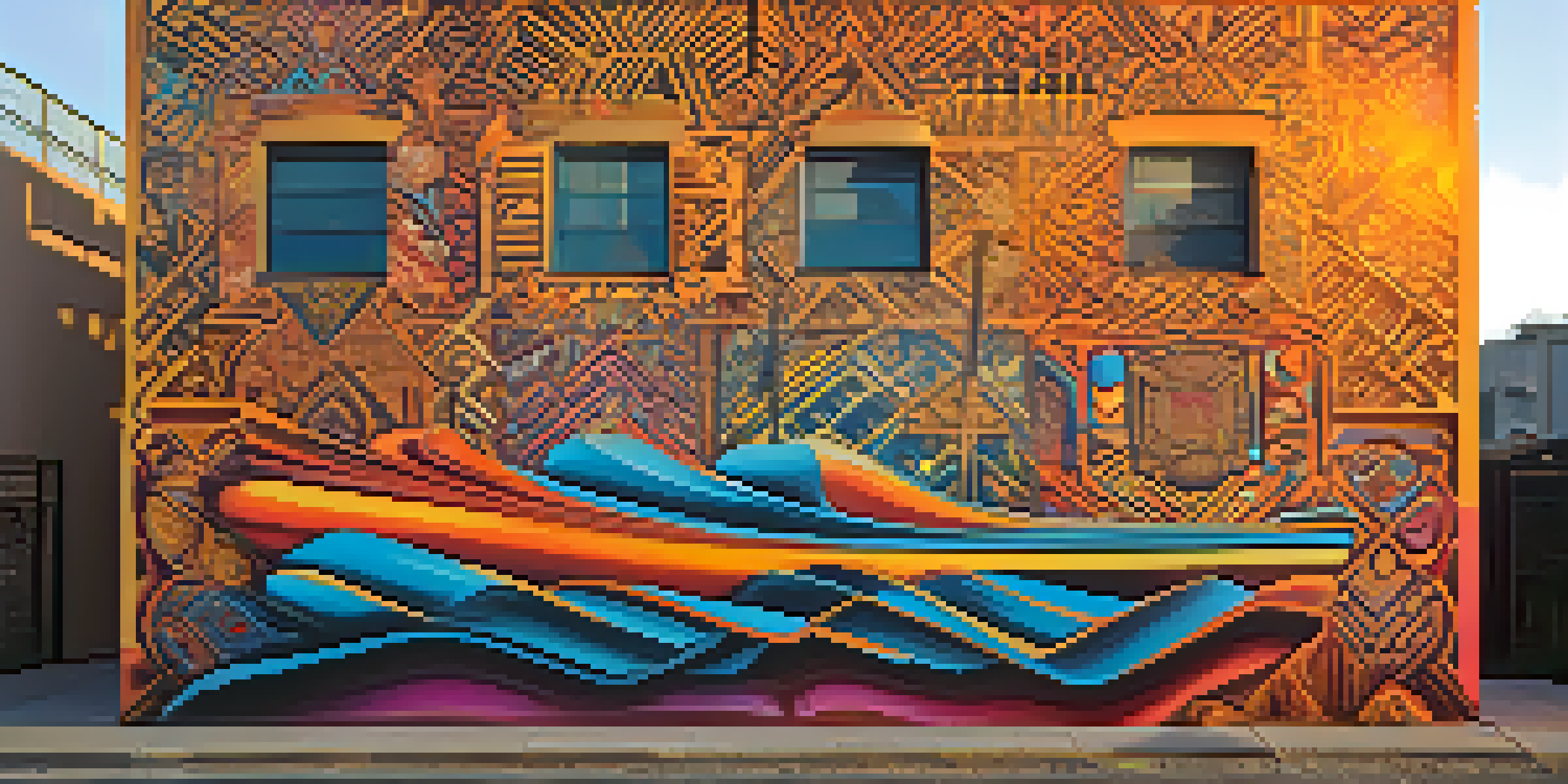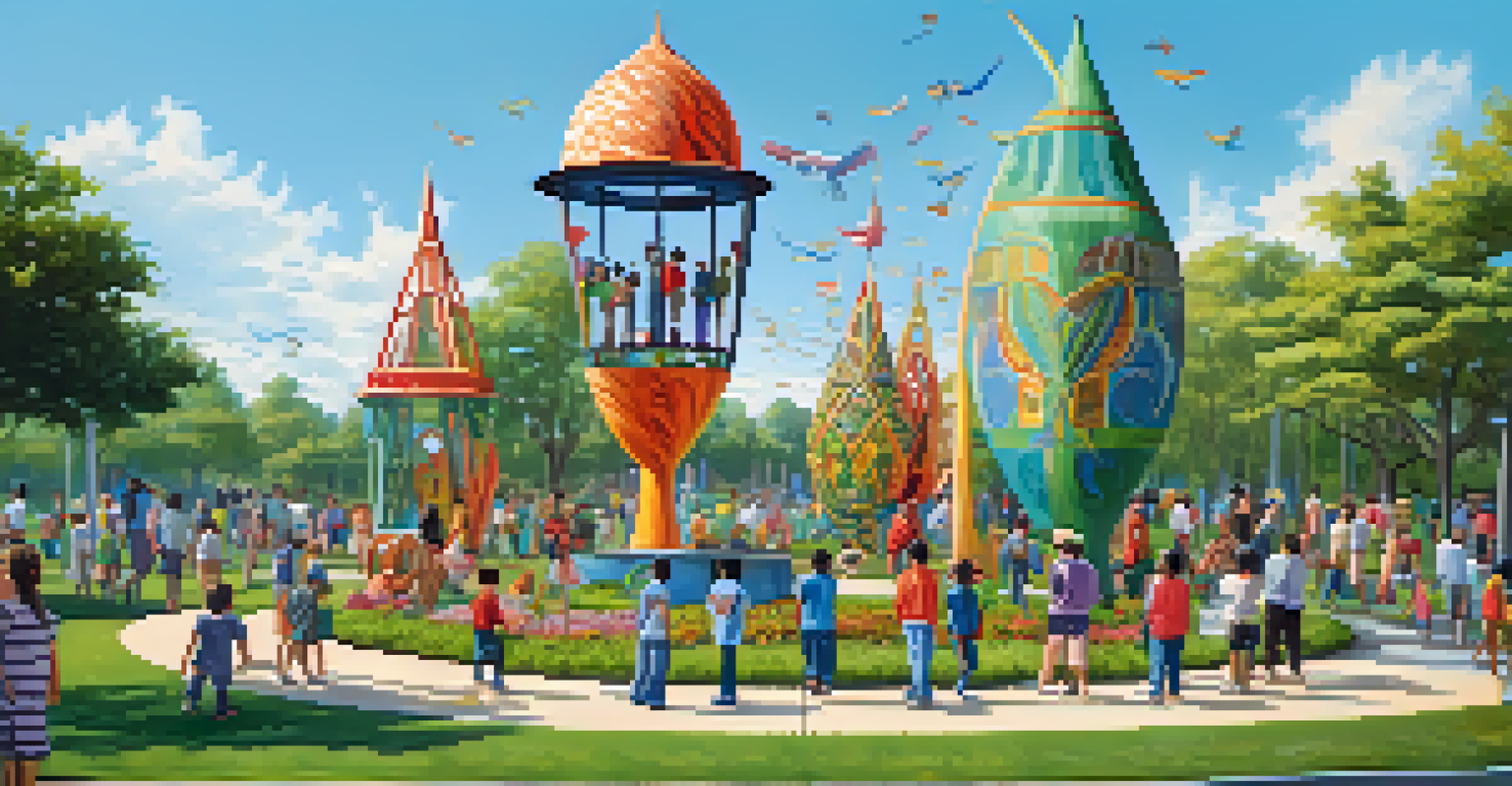Cultural Exchange: Globalization's Role in Art Collaborations

Understanding Cultural Exchange in the Global Context
Cultural exchange refers to the sharing and blending of ideas, traditions, and art forms between different cultures. As globalization connects people across the globe, it creates opportunities for artists to collaborate, learn, and innovate together. This synergy not only enhances artistic expression but also fosters mutual understanding among diverse communities.
Art is a universal language that transcends boundaries and connects us all.
In today's interconnected world, artists can easily access each other's work, ideas, and techniques through digital platforms. This has led to a rich tapestry of artistic collaborations that transcend geographical boundaries. For example, a painter in Spain can easily collaborate with a musician in Japan, creating a unique fusion of visual and auditory art that reflects their respective cultures.
Moreover, cultural exchange encourages the preservation of traditional art forms while also inspiring new interpretations. By blending influences from various cultures, artists can create compelling works that resonate with a wider audience, showcasing the beauty of diversity in the art world.
Globalization: A Catalyst for Artistic Innovation
Globalization acts as a powerful catalyst for innovation in the arts, enabling artists to draw inspiration from various cultural sources. This cross-pollination of ideas leads to fresh perspectives and creative breakthroughs, resulting in art that is both unique and universally relatable. Artists are no longer confined to their local influences but can explore and incorporate global trends into their work.

Take street art, for instance. This vibrant form of expression has roots in various cultures, from graffiti in the United States to mural painting in Mexico. As street artists travel and share their work on social media, they inspire one another, leading to a global movement that celebrates individuality while embracing cultural diversity.
Cultural Exchange Enhances Art
Cultural exchange allows artists to blend ideas and traditions, fostering innovation and mutual understanding.
Furthermore, globalization has made it easier for artists to showcase their work on international platforms. Art fairs, exhibitions, and online galleries provide opportunities for artists to connect with audiences and collaborators worldwide, expanding their reach and influence in the art community.
Collaborative Projects: Bridging Cultures Through Art
Collaborative art projects are a fantastic way to bridge cultural divides, allowing artists from different backgrounds to work together on a shared vision. These projects often result in vibrant works that reflect the unique perspectives of each artist involved. For example, the 'One Million Bones' project brought together artists and communities to raise awareness about social justice through the creation of large-scale installations.
Culture is the widening of the mind and of the spirit.
Such collaborations encourage dialogue between cultures, fostering empathy and understanding. Artists often find common ground in their experiences, leading to a deeper appreciation of each other's backgrounds and artistic practices. This can be especially powerful in areas affected by conflict, where art becomes a tool for healing and reconciliation.
Additionally, collaborative projects can take on various forms, from joint exhibitions to community art initiatives. These endeavors not only enrich the artists' portfolios but also create lasting connections between communities, celebrating the power of art to unite people across cultural divides.
The Role of Technology in Cultural Exchange
Technology plays a pivotal role in facilitating cultural exchange in the arts. With the rise of social media, artists can share their work instantly with a global audience, sparking conversations and collaborations across continents. Platforms like Instagram and TikTok have become essential tools for artists to showcase their creativity and connect with like-minded individuals.
Moreover, virtual collaborations have become increasingly common, especially in a post-pandemic world. Artists can now work together remotely, using tools like video conferencing and collaborative software to create art that transcends physical boundaries. For instance, musicians from different countries can record a song together, blending their unique sounds into a harmonious piece.
Technology Facilitates Collaboration
Advancements in technology enable artists to connect globally, share their work, and collaborate effortlessly, democratizing access to art.
This technological advancement not only enhances the artistic process but also democratizes access to art. Emerging artists from diverse backgrounds can gain visibility and recognition without the need for traditional gallery representation, allowing for a more inclusive art world.
Cultural Appropriation vs. Cultural Appreciation
As artists navigate the waters of cultural exchange, it’s crucial to distinguish between cultural appropriation and cultural appreciation. Cultural appropriation occurs when elements of a culture are used without understanding or respect, often leading to the commodification of those elements. This can create tension and backlash, particularly when marginalized cultures are involved.
Conversely, cultural appreciation involves honoring and respecting the traditions and practices of another culture. Artists who engage in meaningful dialogue, research, and collaboration can create works that celebrate diversity without exploiting it. For example, an artist who collaborates with indigenous communities to incorporate traditional techniques into their work demonstrates appreciation and respect.
By fostering an environment of mutual respect and understanding, artists can contribute to a more equitable art world. This not only enriches their own practice but also encourages a deeper appreciation for the diverse cultural landscapes that inspire their work.
The Impact of Art Collaborations on Society
Art collaborations born from cultural exchange can have a profound impact on society. They often challenge societal norms and provoke thought, encouraging audiences to engage with complex issues. For instance, collaborative pieces addressing climate change or social justice resonate with viewers, sparking conversations that lead to awareness and action.
Additionally, these collaborations can help build community resilience. When artists come together with local communities to create public art, they foster a sense of belonging and pride. This shared experience can empower individuals and inspire collective action, demonstrating the transformative power of art in addressing social challenges.
Art Collaborations Drive Social Change
Collaborative art projects can challenge societal norms and inspire community action, demonstrating the transformative power of art.
Ultimately, art collaborations not only enrich the cultural landscape but also contribute to social change. By harnessing the collective power of diverse voices, artists can create works that inspire, educate, and unite, fostering a more inclusive society.
Looking Ahead: The Future of Cultural Exchange in Art
As globalization continues to evolve, the future of cultural exchange in art looks promising. Emerging artists are increasingly embracing collaboration, using technology to connect with peers worldwide. This trend not only fosters innovation but also encourages the exploration of new mediums and forms of expression.
Moreover, there is a growing recognition of the importance of diversity and inclusivity in the art world. Institutions and organizations are beginning to prioritize collaborative projects that highlight underrepresented voices, ensuring that a wider range of perspectives is celebrated. This shift is vital for the continued enrichment of the global art community.

As we move forward, embracing cultural exchange will be essential in shaping the future of art. By fostering collaboration, understanding, and respect, artists can create works that not only reflect their unique experiences but also resonate with audiences around the world, paving the way for a more interconnected and appreciative art landscape.